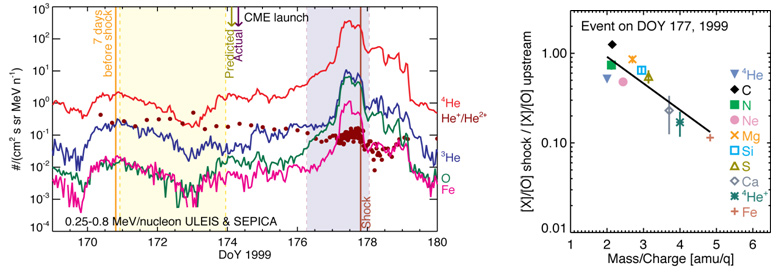
| ACE News Archives | ACE News #119 - Jan 26, 2009 |
Subscribe to ACE News |

Prior to the 1990s the ion intensity enhancements associated with coronal mass ejection (CME)-driven interplanetary (IP) shocks were believed to occur due to the diffusive acceleration of ambient solar wind ions by the shocks as they moved through the IP medium. However, independent surveys of isotopic and ionic charge state composition showed large enrichments of 3He and He+ ions over the corresponding solar wind values in numerous IP shock events (see ACE News #44 and #70). Since both 3He and He+ ions are extremely rare in the solar wind with relative abundance ratios of the order of ~4 x 10-4, these results provided compelling evidence that the seed population for IP shocks contains suprathermal material from a variety of sources that include flare-accelerated 3He-rich material and interstellar pickup He+ ions.
We surveyed the abundances of 0.25-0.8 MeV nucleon-1 He+, 3He, and heavy ions from C-Fe during 18 CME-driven interplanetary (IP) shocks observed near 1 AU between 1997 November and 2000 October. Our results show that each of the 18 shock events is accompanied by significant enhancements in the abundances of both 3He and He+ ions (see figure on the left). In addition we find that, on a case-by-case basis (example shown in the figure on the right), the abundances of He+, 4He and C-Fe ions are depleted systematically as a function of the ion?s mass-per-charge (M/Q) ratio when compared with those measured in the ambient suprathermal ion population upstream of that IP shock (see yellow shaded region in the figure on left).
These results show for the first time that individual IP shocks routinely accelerate ions from multiple seed populations, such as prior solar energetic particle events and pickup ions, via common systematic rigidity-dependent acceleration processes where ions with higher rigidity or M/Q ratios are accelerated less efficiently than those with lower M/Q ratios. We also found that the 3He abundance shows large variations from one shock to the next and is significantly enhanced over the solar wind value. Typically, however, the 3He abundance does not fit into the systematic M/Q-dependent behavior shown in the figure on the right. We suggest this occurs primarily because of significant energy-dependent spectral and compositional differences in the corresponding abundances in the seed population that originates from impulsive SEP events (see Mason et al., Astrophysical Journal, 574, 1039, 2002).
For further details see, Allegrini et al., Astrophysical Journal, Vol. 682, 690, 2008.
This item was contributed by F. Allegrini and M. I. Desai of the Southwest Research Institute, G. M. Mason of the Johns Hopkins University Applied Physics Laboratory, and H. Kucharek and E. Mobius of the University of New Hampshire. Address questions and comments to
Last modified 08 Dec 2008.